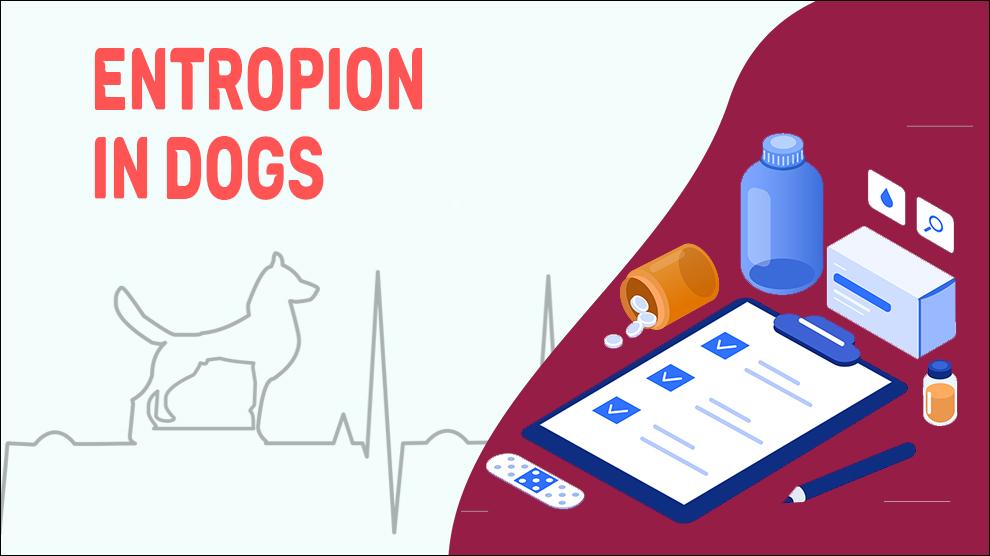What Is Entropion In Dogs?
Entropion is an inversion of eyelids in which the lower eyelid turns in or rolls inward causing cause conjunctival and corneal damage leading to corneal scarring, abrasions, and corneal neovascularization, or corneal thinning. Entropion is a malposition that may occur at the time of squeezing or blinking the eyelids or all the time even when the eyelids are open.
This may result from congenital, acute spastic, cicatricial, and involutional causes. This is also a common condition in breeds with palpebral fissures and eyelids that are disproportionate in length and size. In a few large breeds of dogs, the lower eyelid laxity may vary with the age and fitness of the animal.
Entropion is opposite of ectropion. Ectropion is an eversion of eyelids in which the lower eyelid droops or rolls outward resulting in a droopy or saggy appearance and exposing the delicate bulbar conjunctiva or mucous membrane that is not meant to be exposed in nature.
Entropion can cause Trichiasis, which is a misalignment of eyelashes with posterior misdirection that rub against the eyeball of a dog. Trichiasis also occurs without entropion. Entropion usually leads to ocular surface discomfort and irritation; this may damage the cornea and inflammation or scarring of the conjunctiva.
Symptoms Of Entropion In Dogs
- Squinting, holding the eye shut
- Excessive tears (epiphora)
- Mucoid discharge along the eyelids
- burning or pain in one or both eyes.
- Red, irritated eyes
- Recurring Redness In Eyes or bacterial conjunctivitis,
- Corneal ulceration (appear as disc-like depressions or dull spots)
- Corneal abrasion
- Light sensitivity
Treatment Options For Entropion In Dogs
The objective of Entropion treatment is two-fold: to improve eyelid function and prevent further corneal exposure.
Treatment can be divided into two modalities- medical and surgical.
Medical treatment:
- Allergy medications: Anti-inflammatory (prednisolone or dexamethasone) or antihistamine medications.
- Antibiotics: For the application of the appropriate antibiotic treatment, an antibiogram should be performed (gentamicin, neomycin, Terramycin).
- Antibiotics such as amoxicillin, chloramphenicol, gentamicin, tobramycin, ciprofloxacin, oxytetracycline, etc.
- Eye pain and spasm- ophthalmic atropine ointment or drops.
Surgical procedure: Ophthalmologist will remove a section of skin directly from below the eyelid to reverse the inward rolling and both the sides of the skin will be sutured.
Home Remedies For Entropion In Dogs
- Supplementing for healthy eyes: Help your dog have healthy ocular hygiene with supplements.
- Use physiological saline or a commercial eye cleansing agent: (such as Eye Scrub) or lactated Ringer’s solution.
- Apply warm compresses for 5 to 15 minutes, 3 to 4 times daily, avoiding surfaces of the eyes.
- Apply cooled chamomile tea to a cotton ball and clean the affected eye.
Prevention Of Entropion In Dogs
Entropion due to the hereditary abnormality can be prevented by stopping the breeding of affected dogs so that the risk of passing the condition on to the next generation is averted.
Trauma-related or infections: try to prevent or avoid the traumatic issues and infections.
Affected Dog Breeds Of Entropion
Chow Chow, Akita, Bernese Mountain Dog, Basset Hound, Bulldog, Bloodhound, Dalmatian, English Springer Spaniel, Golden Retriever, Great Pyrenees, Great Dane, Irish Setter, Labrador Retriever, Newfoundland, Mastiff, Old English Sheepdog, Pug, Pomeranian, Pekingese, Rottweiler, Saint Bernard, Shih Tzu, Shar Pei, Staffordshire Bull Terrier, Siberian Husky, Toy Poodle, Miniature Poodle, Tibetan Spaniel, Weimaraner, Yorkshire Terrier
Additional Facts For Entropion In Dogs
1. Causes:
Congenital entropion
Many breeds of dogs are genetically predisposed.
Acquired entropion
- Facial nerve paralysis
- Viral and bacterial infections
- Birth trauma
- Temporal bone fracture, Fractures to the skull base
- Disinsertion or attenuation of eyelid retractors
- Facial injuries
- Horizontal eyelid laxity
- Overriding by the preseptal orbicularis oculi muscle
2. Mortality: There is no mortality due to this condition documented yet.
3. Diagnosis:
- Tonometry, slit lamp, and fundoscopy
- Inner eye gonioscopy
- Biomicroscope
- conjunctival cytology or biopsy
- Intraocular pressure testing
- Corneal stain testing
4. Prognosis:
Entropion isn't a lethal condition, but it can ultimately lead to eye problems. Discuss with your vet to figure out the underlying cause.
Depending on the cause, entropion can be treated with either medication to keep the eyes moisturized or surgery.
When To See A Vet For Entropion In Dogs?
Contact your vet right away, if you notice any of the following:
- Squinting, holding the eye shut
- Excessive tears (epiphora)
- Mucoid discharge along the eyelids
Food Suggestions For Entropion In Dogs
The diet should be included foods containing vitamins A, C, omega 3s, zinc, carotenoids, beta-carotene, lycopene, and antioxidants.
- Omega-3 oily fishes such as salmon, tuna, cod, etc.
- Leafy greens such as spinach, kale, watercress, etc.
- Nonmeat/plant protein sources such as nuts, Lentils, Beans, Eggs, etc.
- Citrus fruits or juices, Sweet potatoes, tomatoes, pumpkin.
- Zinc foods such as Pork, tuna, and Oysters.
- Blueberries, Broccoli, cabbage, carrots, etc.
Conclusion
The cause of the Entropion determines the prognosis.
Trauma causes of Entropion have a guarded prognosis and are not at risk of developing problems in the future.
Congenital abnormality caused by Entropion can be surgically corrected, and the prognosis is excellent.

















